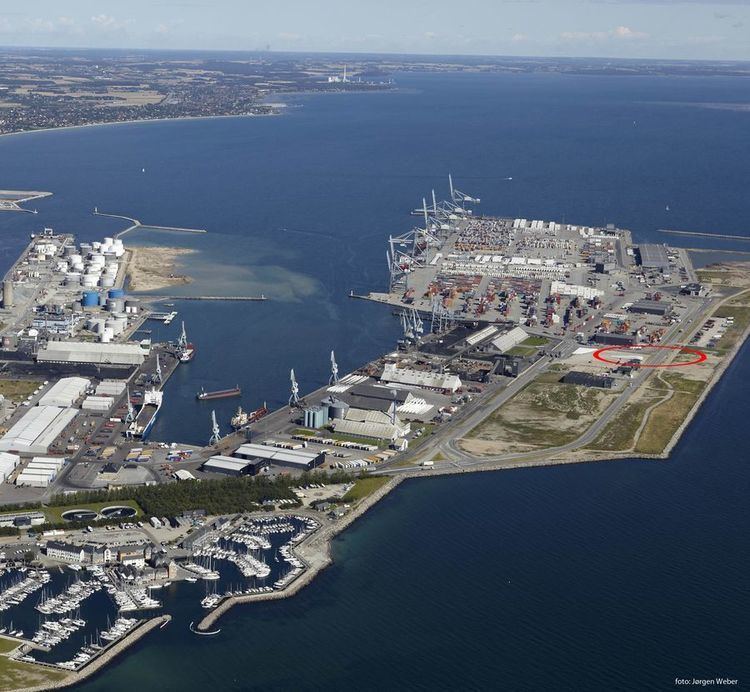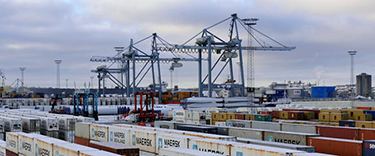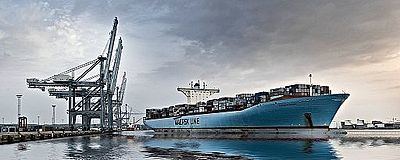Type of harbor Deep-water seaport | Location Aarhus Owned by Public Annual cargo tonnage 7.6 million (2014) Opened 1845 | |
 | ||
Port of aarhus
The Port of Aarhus (Danish: Aarhus Havn) located in the city of Aarhus is a deep-sea port and the largest container port in Denmark with a national 50% market share in container handling. The Port of Aarhus shipped roughly 7.6 million metric tonnes of cargo in 2014.
Contents
- Port of aarhus
- Evelyn m rsk in port of aarhus
- Geography
- Administration
- History
- Harbour terminals
- Economy
- References

Evelyn m rsk in port of aarhus
Geography

The Port of Aarhus is located in central Aarhus at the mouth of the Aarhus River on the Bay of Aarhus in Kattegat. The port faces Helgenæs to the East, Samsø to South East and on the coast the Marselisborg Forests lies to the South and Riis Skov lies to the North.
Administration

The Port of Aarhus is owned and managed by Aarhus Municipality as a financially independent company. The mayor and two city council members are automatically granted seats on the board of directors after municipal elections with the mayor assuming the position of chairman. The board consists of 7 members; 3 city council members, 3 members with a background in business and 1 representative elected among the employees of the port.
History

Aarhus is one of the oldest cities of Denmark, founded in the Viking Age in the 8th century at a natural harbor on the northern shores of a fjord. The fjord gradually narrowed into a river and in the 19th century the harbor was moved to the coast by the newly formed city council. In 1845-61 and 1883-90 the harbor was successively expanded into what became Nordhavnen (The North Harbor). In 1905-11 Sydhavnen (The South Harbor) was constructed in the form of a new, larger pier extending from the South along the East side of the harbor. In 1935-60 and 1984-1992 the North Harbor was expanded again and from 1975 another larger pier was constructed from South to North East.

Through the Middle Ages the harbor primarily exported grain to Norway and Germany from the large agricultural catchment areas around Aarhus. In the early 19th century, as the Industrial Revolution took hold, imports became predominantly coal and iron based and in the 1880 it was supplemented by feedstuffs, fertilizer and grain as Danish agriculture changed from grain export to animal husbandry. In the 1870s grain exports started to decline as the new harbor in Esbjerg absorbed agricultural exports from Jutland but it was offset in the early 20th century by exports of oils, feedstuffs, processed foods and industrial products.

In 1997 Århus City Council announced a Masterplan for expansion and development of the port. The expansion will double the harbor area to 350 heactares. The oldest and most central areas in Nordhavnen will be converted to residential areas in the form of the new neighborhood Aarhus Ø.
Harbour terminals
The port of Aarhus includes 6 terminals; container, multi, bulk, tanker, ferry and cruise terminals. The container terminal The container terminal includes 1300 meters of pier, 750.000 m2 and a water depth of 14 meters with 3 Post-Panamax cranes, 4 Super Post-Panamax cranes, 1 Panamax crane. The Multi terminal handles bulk cargo such as coal and feedstuffs and project cargo such as wood and windmills. The bulk terminal handles loose cargo such as grain, sand and gravel. The tanker terminal handles mineral oils, gasoline, chemicals, molasses and cement. The ferry terminal is mainly used by Mols-Linien which operates a route to Odden but there are also irregular ro-ro ferries to Finland and Copenhagen. The cruise terminal receives cruise ships primarily from the Baltic Sea. In 2016 an air service began from Aarhus to Copenhagen via a float plane. Flight time takes around 40 minutes compared to a train journey close to 3 hours.
Economy
The Port of Aarhus maintains a large industrial area home to some 150 companies primarily in the transport and industry sectors which employs some 10.000 people. As of 2015 it is the largest containerport in Denmark with a market share of almost 60% and the largest public bulk terminal in the country. The ferry terminal services around 1.000.000 vehicles and some 2.000.000 passengers yearly.
